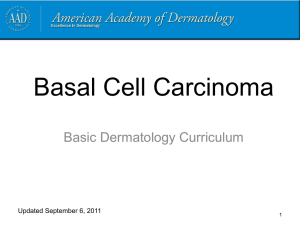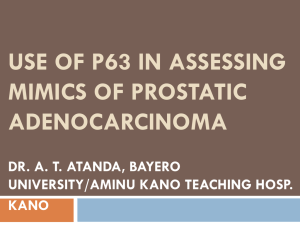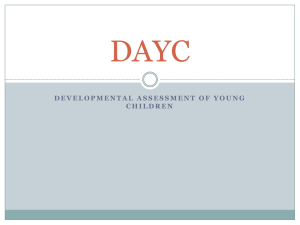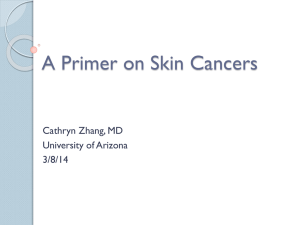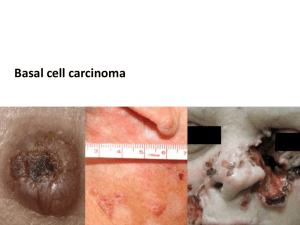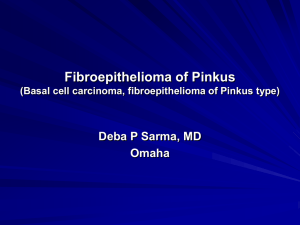Guidelines for the management of basal cell carcinoma
advertisement
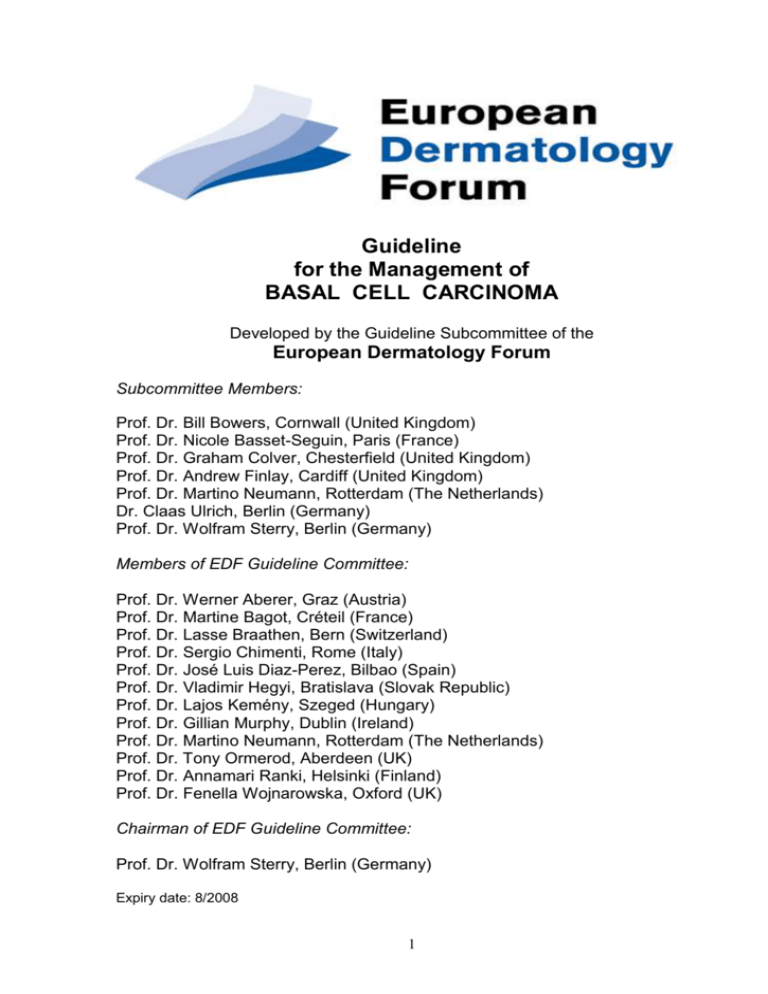
Guideline for the Management of BASAL CELL CARCINOMA Developed by the Guideline Subcommittee of the European Dermatology Forum Subcommittee Members: Prof. Dr. Bill Bowers, Cornwall (United Kingdom) Prof. Dr. Nicole Basset-Seguin, Paris (France) Prof. Dr. Graham Colver, Chesterfield (United Kingdom) Prof. Dr. Andrew Finlay, Cardiff (United Kingdom) Prof. Dr. Martino Neumann, Rotterdam (The Netherlands) Dr. Claas Ulrich, Berlin (Germany) Prof. Dr. Wolfram Sterry, Berlin (Germany) Members of EDF Guideline Committee: Prof. Dr. Werner Aberer, Graz (Austria) Prof. Dr. Martine Bagot, Créteil (France) Prof. Dr. Lasse Braathen, Bern (Switzerland) Prof. Dr. Sergio Chimenti, Rome (Italy) Prof. Dr. José Luis Diaz-Perez, Bilbao (Spain) Prof. Dr. Vladimir Hegyi, Bratislava (Slovak Republic) Prof. Dr. Lajos Kemény, Szeged (Hungary) Prof. Dr. Gillian Murphy, Dublin (Ireland) Prof. Dr. Martino Neumann, Rotterdam (The Netherlands) Prof. Dr. Tony Ormerod, Aberdeen (UK) Prof. Dr. Annamari Ranki, Helsinki (Finland) Prof. Dr. Fenella Wojnarowska, Oxford (UK) Chairman of EDF Guideline Committee: Prof. Dr. Wolfram Sterry, Berlin (Germany) Expiry date: 8/2008 1 List of conflicts of interest: Prof. Dr. Andrew Y. Finlay, Cardiff (UK) is on the UK 3M Dermatology Advisory Board Prof. Dr. Wolfram Sterry, Berlin (Germany) is a consultant for 3M Pharmaceuticals Prof. Dr. Nicole Basset-Seguin, Paris (France) Is a consultant for 3M Pharmaceuticals and Galderma 2 Guideline for the management of basal cell carcinoma Prepared on behalf of the European Dermatology Forum by: B Bowers 1, N Basset-Seguin 2, G Colver 3, AY Finlay 4, M Neumann 5, C Ulrich 6, W Sterry 6 (chairman) 1 Dermatology Department, Treliske Hospital, Truro, Cornwall, United Kingdom 2 Department of Dermatology, Hôpital Saint-Louis, 1 avenue C Vellefaux 75010 Paris, France 3 Dermatology Department, Chesterfield Royal Hospital NHS Foundation Trust, Chesterfield, Derbyshire S44 5BL, United Kingdom 4 Department of Dermatology, Wales College of Medicine, Cardiff University, Heath Park, Cardiff, CF14, 4XN Wales, United Kingdom 5 Department of Dermatology and Venereology, Erasmus Medical Center, Rotterdam, The Netherlands 6 Department of Dermatology, Venerology and Allergology, Charité Campus Mitte, 10117 Berlin, Germany 3 Disclaimer This guideline for the management of basal cell carcinoma (BCC) is based on that prepared by the British Association of Dermatologists and has been prepared by the BCC subcommittee of the Guidelines Committee of the European Dermatology Forum. It represents an evidence-based guidance for treatment, with identification of the strength of evidence available at the time of preparation of the guideline, and a brief overview of epidemiological aspects and clinical management of patients with BCC. Many different and well-accepted treatments are used in the management of BCC. 1 This guideline aims to aid selection of the most appropriate treatment for individual patients. 4 Definition BCC is a slowly growing, locally invasive malignant epidermal skin tumour, which exhibits a differentiation potential comparable to at the embryonic hair bud. BCC tends to infiltrate tissues in a three-dimensional contiguous fashion through the irregular growth of subclinical finger-like outgrowths. 2 Metastases are extremely rare, and the morbidity associated with BCC is related to local tissue invasion and destruction; growth pattern largely correlates with the aggressiveness of the tumour. 3,4,5 The tumour is mainly located on the head and neck and mainly affects Caucasians. The multipotent differentiation potentential is reflected by a larger diversity in clinical appearance and morphology, i.e. nodular, cystic, ulcerated, superficial, morphoeic (sclerosing), keratotic and pigmented variants. Histological subtypes can also serve a prognostic factor (Table1). Incidence/prevalence BCC is the most common cancer in the U.S.A., Australia and Europe; its incidence (new cases/100.000 inhabitants/year) increases worldwide with the following numbers being reported: 1998: 128/105 male/female/ 100.000 in South Wales, Great Britain; 2058/1195 male/female/100.000 in Northern Australia. 6-8 The most significant aetiological factor is exposure to ultraviolet radiation. Sun exposure during childhood may be especially critical in the development of BCC in adult life. 9,10 Patients with BCC on head and neck show different phenotypes, including one with continuous development of BCC clusters on the trunk. Such patients are generally younger than patients with BCC on head and neck only. 11 Further risk factors are increasing age, male sex (18-40% more common in white men than women, skin type 5 I and II) and chronic immunosuppression.. 12,6 Multiple BCCs may also arise in basal cell nevus (Gorlin's) syndrome. 13 Once a person has developed a BCC there is a significantly increased risk of developing subsequent BCCs at other sites. 14-15 There is evidence that epidemic of BCCs in Australia is beginning to abate, especially in younger people, possibly as a result of adequate photoprotection. 16 Diagnosis and Investigation Ideally the treatment of BCC is based upon a clinical diagnosis. Where clinical doubt exists, or when patients are referred for specialized forms of treatment, histology is crucial. Information on the prognosis will be provided by histological subtype of the BCC. Clinically the extent of penetration of tumours is impossible to judge. Scanning techniques such as CT and MRI may be rarely needed.17 Prognosis and the concept of “low-risk” and high-risk” basal cell carcinomas The histological subtype may correlate with prognosis, and thereby may be used to describe BCCs as low or high risk (Table 1). Management The aim is to completely cure the tumour with the best cosmetic result. The early detection and appropriate (re-)treatment of either recurrent BCCs or new primary BCCs may help to increase the chances of permanent cure and to minimize morbidity. Patient education together with close collaboration with colleagues in primary care should allow the vast majority of adequately treated patients to be discharged back to the care of their general practitioners or dermatologists in private practice. 6 The relative value of the available forms of therapy for BCCs of different sizes, clinical and histological subtypes and involving both high- and low-risk body sites are summarized in Table 3 (primary BCCs) and Table 4 (recurrent BCCs). Surgical techniques The most commonly used surgical techniques can be divided into main categories: A.) Excision with predetermined margins The aim of any excisional procedure is to eradicate the tumour entirely. Discussion of the surgical excision of BCC is divided into the following sections: 1 Primary (previously untreated) BCC. Surgical excision is a highly effective treatment for primary BCC. be examined histologically 18-19 20-21 (Strength of Evidence A, II-ii) The excised tissue can and the peripheral and deep surgical margins can be grossly assessed. The overall cosmetic results are usually good. The use of thorough curettage prior to excision of primary BCC may help to increase the cure rate by more accurately defining the true borders of the BCC. 22 The size of the surgical margins should correlate with the likelihood that subclinical tumour extensions exist. Few data exist on the correct deep surgical margin, as this will depend upon the local anatomy. Studies using horizontal frozen sectioning Mohs micrographic surgery (MMS) to detect accurately BCC at any part of the surgical margin suggest that, for a small (< 20 mm) well defined BCC, 3 mm peripheral surgical margins will clear the tumour in 85% of cases (and a 4-5 mm margin will increase the peripheral clearance rate to approximately 95%, i.e. approximately 5% of small, well-defined BCCs show 7 subclinical spread of > 4 mm. 2, 23) In contrast to small primary BCCs, morphoeic and large BCCs require wider surgical margins for complete histological resection. For primary morphoeic BCC, the rate of complete excision with increasing peripheral surgical margins is as follows: 3 mm margin: 66%, 5 mm margin: 82%, 13-15 mm margin: > 95%. 23 Positive margins are most often seen in morphoeic and facial tumours and are associated with a 26% recurrence rate over 5 years compared to 14% with free margins. 24 In the lid or periorbital area incompletely excised and morphoeic tumours were shown to have a 50% risk of recurrence. 25 2 Recurrent (previously treated) BCC. The results of all published series on the surgical excision of BCC show that cure rates for recurrent BCC are inferior to those for primary lesions. 26 Recurrent BCCs require wider peripheral surgical margins than primary lesions with or without standard (non-Mohs) frozen section control. 20 Peripheral excision margins for recurrent BCC of 5-10 mm have been suggested. 27 (Strength of Evidence A, II-ii) 3 Incompletely excised BCC (positive histological margins). This scenario should not occur following excision with histological control of margins. However if closure is completed before histological assessment there will be instances that the pathologist reports tumour present at the lateral and/or deep margin of excision. In some cases this may be apparent, not real, and due to tangential slicing of the specimen or tissue shrinkage. A study in which 43 incompletely excised BCCs were re-excised and the tissue examined using standard tissue sectioning techniques suggested that only 7% contained residual BCC. 28 However, when 78 incompletely excised BCCs were re- excised and examined using horizontal frozen sectioning (Mohs micrographic surgery) 8 in order to detect BCC more accurately at any part of the surgical margin, 55% were found to contain residual BCC. 29 (Strength of Evidence A, II-iii) These findings were in accordance with another study demonstrating a tumour persistence in 28% of cases following incomplete excision of BCC. 30 Several studies have demonstrated that not all tumours will recur despite positive margins but the recurrence rate varies from 17-58%. The lowest rates were for lateral margin involvement only. The higher rates were for deep and lateral margin involvement, for tumours which were previously recurrent and those which had been treated by radiotherapy. 28-29,31-34 In a series of 187 incompletely excised BCCs, with 93% occurring on the head and neck, 119 were immediately retreated with radiotherapy, one was excised and 67 were not treated. After a median follow-up period of 2.7 years, statistical analysis suggested a 5-year probability of cure in the radiotherapy group of 91%, and in the untreated group of 61%. 34 So what advice should the patient be given? Several studies have strongly recommended the immediate retreatment of incompletely excised BCC especially those where the surgical defect has been repaired using skin flaps or skin grafts. 29-30, 30, 33, 35-36 There may be occasions when a patient with a low risk primary tumour with possible lateral margin involvement opts for a period of observation. However generally it seems appropriate to without frozen section control or Mohs micrographic surgery. 9 re-excise with or B.) Stepwise excision with histology control of margins Micrographic surgery might serve as a treatment of choice for large or difficult primary BCC lacking distinct clinical boundaries. 37 The histological mapping of the tumour’s margins preserves tumour-free adjacent tissue, optimizes wound reconstruction and reduces the percentage of additional excisions in order to remove the tumour completely. 38 (Strength of Evidence A II-iii) This specialized minimal surgery was initially developed by Mohs and offers highly accurate yet conservative removal of BCC. 39-40 The indications for using Mohs micrographic surgery are summarized in Table 2. (Strength of Evidence A, II-i) A review of all studies published since 1947 suggested an overall 5-year cure rate of 99% following Mohs micrographic surgery for primary BCC 41 and a review of all studies published since 1945 suggested an overall 5-year cure rate of 94.4% following Mohs micrographic surgery for recurrent BCC. 26 In addition to Mohs micrographic surgery, further fresh tissue micrographic techniques exist: both the margin strip method (“Tübinger Torte”) as well as the “Munich” method follow the same aim of complete tumour resection though they differ in some points, for example in the preparation or technique of tumour excision. 38 The latter method was the treatment of choice for the excision of 3065 BCCs in 2795 patients. In 53.3% of all BCC, the first excision led to a complete tumour removal, another 36.9% were free of BCC after a second excision. Interestingly, clearance with one step excision ranged between 80% of adenoid-cystic, >50% of solid but only 43% of morphea-like BCC. The follow-up period over more than 5 years resulted in recurrences of BCC in 41 of 1604 patients (2.6%). 36% of these recurrent BCCs were re-recurrent tumours, 64% of these tumours were initially primary BCCs. 10 When compared with other outpatient-based treatments for BCC, these specialized methods undoubtedly offer high cure rates but are relatively expensive and time consuming. Non-surgical techniques Destructive techniques without histological control Curettage and cautery/electrodesiccation There are wide variations in how this technique is performed (e.g. type of curette used, number of cycles of treatment) and both experience in the technique and appropriate selection of cases is crucial to success.42 Curettage and cautery is best used for selected low-risk lesions (small, well defined primary lesions with nonaggressive histology usually in non-critical sites 97% are possible. 43 43-44 where 5-year cure rates of up to Curettage and cautery is not recommended for the management of large 44 and other 'high-risk' tumours.42,45-48 Tumour size is an important factor as the recurrence rate rises dramatically with increasing tumour size. 44 (Strength of Evidence [Appendix] A, II-iii) A literature review of all studies published since 1947 suggested an overall 5-year cure rate of 92.3% following curettage and cautery for primary BCC. 41 However, a similar review of all studies published since 1945 suggested an overall 5-year cure rate of 60% following curettage and cautery for recurrent BCC. This supports the view that curettage and cautery is much less useful in the treatment of recurrent BCC, especially in high-risk sites. 26 (Strength of Evidence A, II-ii) 11 Cryotherapy Cryosurgery is widely used to treat solitary and multiple BCCs. Individual technique can vary considerably, using the open or closed spray techniques and single, double or triple freeze/thaw cycles. 49-50 Many large published series specifically exclude the treatment of very high-risk BCCs, emphasizing the importance of careful selection of appropriate lesions with nonaggressive histology, away from critical facial sites in order to achieve high cure rates. 48, 50-52 (Strength of Evidence A, II-ii) There are reports in the ophthalmological literature recommending the use of cryo-surgery for periocular BCC, although fullthickness eyelid defects may occasionally result and require subsequent plastic surgical reconstruction. 53-54 Thorough curettage immediately prior to cryosurgery may help to increase the cure rate. 55 (Strength of Evidence A, II-ii) As with most treatment modalities, cryosurgery is less useful in the treatment of recurrent BCC. 41 Post-operative wound care can be a problem. However, the treatment is usually well tolerated when performed on a local anaesthetic, outpatient basis and the cosmetic results can be excellent. 51,56 Carbon dioxide laser Carbon dioxide (CO2) laser surgery is not a widely used form of treatment and there is little published follow-up data. The treatment is mainly recommended for low-risk 12 lesions. When combined with curettage, CO2 laser surgery may be useful in the treatment of large or multiple superficial BCCs. 57-58 Radiotherapy Radiotherapy (RT) is an extremely efficient form of treatment, but faces the same problem of accurately identifying tumour margins as standard excisional surgery. 34.5960 RT includes a range of treatments using different types of equipment, each with its own specific indications and side-effects. It is therefore best performed by specialized dermatological centers or by clinical oncologists with a specialist interest in skin cancer. Careful patient selection can result in very high cure rates; in a series of 412 BCCs treated with RT, 5-year cure rates of 90.3% were achieved. 18 In a prospective trial, where 93 patients with BCC were randomized to receive either cryosurgery or radiation therapy; the 2-year cure rate for the RT group was 96%. 52 A review of all studies published since 1947 suggested an overall 5-year cure rate of 91.3% following RT for primary BCC and a review of all studies published since 1945 suggested an overall 5-year cure rate of 90.2% following RT for recurrent BCC. 26,41 Radiotherapy can be used to treat many types of BCC, even those overlying bone and cartilage, although it is probably less suitable for the treatment of large tumours in critical sites, as very large BCC masses are often both resistant and require radiation doses that closely approach tissue tolerance. However, surgery should be preferred for BCC of the face measuring < 4cm in diameter. 61 Radiotherapy is also not indicated for BCCs on areas subject to repeated trauma such as the extremities or trunk and for young patients as the late-onset changes of cutaneous atrophy and telangiectasis may result in a cosmetic result inferior to that 13 following surgery. 59,62 It can also be difficult to use RT to re-treat BCCs that have recurred following RT. Modern fractionated dose therapy has many advantages but requires multiple visits to a specialist centre. Late-onset fibrosis may cause problems such as epiphora and ectropion following treatment of lower eyelid and inner canthal lesions, where cataract formation is also a recognized risk, although this can be minimized by the use of protective contact lenses. 63 There is some suggestion that BCCs recurring following RT may behave in a particularly aggressive and infiltrative fashion, although this may simply reflect that these lesions were of an aggressive, high-risk type from the very beginning.33.64-65 Topical therapy Topical 5-fluorouracil (5FU) Treatment is especially useful for low-risk, extrafacial BCC but it cannot be expected to eradicate invasive BCC. 66 (Strength of Evidence A, II-ii) Topical Imiquimod Imiquimod is an immune response modifier (IRM). It has been successfully used for the treatment of cutaneous neoplasias as well as viral skin diseases and acts as an antitumour agent principally by both production alpha interferon and other cytokines and induction of apoptosis.67 The use of imiquimod 5% cream for the treatment of superficial (sBCC) and nodular BCC (nBCC) was recently investigated comparing low frequency dosing with and without occlusion for 6 weeks. In patients with superficial BCC the highest complete clearance rates ranged between 87% with occlusion (20 of 23 patients) and 76% without occlusion (19 of 25 patients). Several studies have shown a clearance rate 14 (judged at 3 months with histology) of 87.9% with one application/day for 6 weeks 68 and of 80.8% (with one application /day/5 days/w for 6 weeks) 69 in sBCC without occlusion. If applied 5 times per week for 6 weeks (pooled analysis of two double-blind vehicle controlled clinical trials) a histological clearance was noted in 82% (152/185) of patients. 70, 71 Clearance was assessed by excisional histology at the completion of treatment. Interim results from a long-term open-label uncontrolled study indicate an estimated sustained clearance of 92% at 12 months. The recommendation of prescription of imiquimod for the treatment of sBCC is actually once/day, 5 times/week for 6 weeks. 69 (Table2,3) (Strenght of Evidence A,I) In the nodular BCC group (7 days per week treatment, 12 weeks therapy) the percentage of complete responders was only 76% (16 of 21) and 71% (7 days per week, 6 weeks) (25 of 35).72 Therefore imiquimod is not actually recommended for the treatment of nodular BCC. A successful treatment of multiple BCCs with topical imiquimod in nevoid basal cell carcinoma syndrome (Gorlin-Goltz syndrome) was also reported. 73 Photodynamic therapy Mainly due to its good cosmetic outcome the use of topical photodynamic therapy (PDT) in the management of BCC becomes more and more available in dermatological centres. In a study of 151 BCCs treated with PDT without long-term follow-up, 88% demonstrated a complete response. 74 (Strength of Evidence C, II-iii) Long-term follow-up data on large series is needed to demonstrate whether or not topical PDT has a role in the management of BCC. Methyl aminolevulinate PDT was recently shown to be an effective treatment even for nodular BCC. 15 75 However, as depth of penetration of the photosensitizer appears to be a limiting factor with topical PDT, without previous curettage PDT it is only likely to be of benefit for the treatment of superficial BCC in low risk areas. 75-76 (Strength of Evidence C, III) A report from the British Photodermatology Group suggests topical ALA-PDT to be an effective therapy for superficial (<2 mm thick) BCC. (strength of recommendation A, I) 77 Chemotherapy Chemotherapy has been used both for the management of uncontrolled local disease and for patients with metastatic BCC, which is both an extremely rare and a rapidly fatal condition.3 A cisplatin (CDDP)- based chemotherapy (including doxorubicin) as sole therapy and as neoadjuvant (NA) therapy revealed a complete remission in eight of 28 patients (28%) suffering from advanced basal cell and squamous cell cancers, a partial remission was achieved in 11 of 28 patients (40%) 78 Palliation and observation In some instances the patient’s general health or condition may indicate palliation and / or observation. The risk /benefit ratio must be considered individually to assess whether the cases warrants only palliation, observation or both. 79 In the debilitated patient aggressive treatment may be inappropriate. Observation alone or simple debulking or RT may achieve local control and improve quality of life. Retinoids Oral retinoid therapy may prevent or delay the development of new BCCs. Such therapy has mainly been used in patients with the basal cell nevus (Gorlin's) 16 syndrome and may also have a lesser effect in producing partial regression of existing BCCs. 80 A recent study questioned the benefit of acetretin in preventing BCCs. 81 Unfortunately, the relatively high doses necessary mean that compliance may be poor, and relapse occurs following the discontinuation of treatment. 80 (Strength of Evidence B, III) Follow-up Long-term hospital-based follow-up of all patients after treatment of BCC is neither necessary nor recommended. However, follow-up can be important for selected patients, although there is no clear consensus on either the frequency or total duration or such review. The main arguments for follow up are: (i) early detection of tumour recurrence; (ii) early detection and treatment of new lesions; and (iii) patient education, especially regarding sun protection measures. Most evidence suggests that the majority of BCCs that recur, will present within 5 years of treatment, to 18% will recur after this. 41 82 although up A review of all studies published since 1947 suggested that for primary (previously untreated) BCCs treated by a variety of modalities less than one-third of all recurrences occurred in the first year following treatment, 50% appear within 2 years, and 66% within 3 years. 41 Patients who have had one BCC are at significantly higher risk of developing new primary lesions, 14,83 many of which may go unnoticed by patients. In a 5-year prospective follow-up study of 1000 patients following treatment for BCC, 36% developed new primary BCCs and 20% of patients with very fair skin types and frequent sun exposure went on to develop multiple BCCs. 15 Consequently, some authors have recommended long-term, even lifetime follow-up, particularly for patients with high-risk or multiple lesions. 17 41,83 In contrast to this special group patients with single BCCs completely excised in low risk sites possibly do not require follow up.80 Additional considerations Once the tumour has been assessed the most appropriate treatment options must be discussed with the patient. Although surgery is the gold standard there are some circumstances, which will affect the final decision. Patients reluctant to consider any form of surgery might be referred for radiotherapy. Similarly, co-existing medical conditions or drug medication may influence the choice between surgical and nonsurgical treatment. Aggressive treatment might be inappropriate for patients of advanced age or poor general health, especially when dealing with asymptomatic lowrisk lesions that are unlikely to cause significant morbidity. Some elderly or frail patients with symptomatic or high-risk tumours might prefer less aggressive treatments designed to palliate rather than cure their tumours. Local availability of various specialized services, together with the experience and preferences of the dermatologist managing the case are also factors that will influence the selection of therapy. A great variety of skills is needed to manage the spectrum of problems thrown up by basal cell carcinoma. Multidisciplinary teams are of great value in difficult high-risk tumours in order to obtain both the highest clearance rates and best cosmetic results. Essential members of such a team are likely to cover the specialties of dermatology, diagnostic imaging, histopathology, oncology, radiotherapy and specialised surgery e.g. dermatologists, plastics, maxillofacial, ophthalmology. Such close collaboration has an additional educational benefit for all parties. 18 Guideline development standard operating Procedure of EDF Step 1 2 3 4 Responsible EDF Guidelines Committee (EDF-GC) EDF Guidelines Committee EDF Guidelines Subcommittee (EDFGSubC) EDF Guidelines Subcommittee 5 EDF Guidelines Subcommittee 6 EDF Guidelines Subcommittee Chairperson 7 8 EDF Guidelines Subcommittee 9 Chairperson 10 14 Guidelines Subcommittee Chairperson of Subcommittee EDF Guidelines Committee EDF Guidelines Committee chairperson EDF secretary 15 EDF 11 12 13 Expiry date 7/2008 ICD-10 C 44.- Task Decision of topic of specific guideline Foundation of subcommittee for specific guidelines, nomination of EDF members (50 %) Identify all existing guidelines for the specific guideline (active process: literature survey plus contact to Dermatological Societies) Select the guidelines with highest quality. Criteria for selection: 1. Availability of strength of evidence 2. Availability of strength of recommendation 3. Evidence of mechanics of literature review Identification/nomination of additional 50 % EDF members for the EDF-GsubC from amongst the authors of the best guidelines Nomination of chairperson for EDF-GSubC from the GSubC members Consider involvement of other disciplines and patients´ organisations Meet 1. to decide the author of the first draft and to discuss the present guidelines, their strengths and weaknesses 2. 6 months later to discuss the draft (consensus conference) Circulate the guideline draft to national dermatological societies for comments Circulate final version for approval among members of the guideline subcommittee Deliver final version to EDF guideline chairperson Review and comment guideline Send guideline for official approval to UEMS (formal approval) Distribute guideline for in advance information to EDF members and National Dermatological Societies Publication 1. on EDF homepage 2. in European Journal of Dermatology, British Journal of Dermatology and Journal of Deutsche Dermatologische Gesellschaft 3. If publication in other national journals is requested by the respective society, this will be encouraged by the EDF 19 References 1 Albright SD. Treatment of skin cancer using multiple modalities. J Am Acad Dermatol 1982; 197: 143-71. 2 Breuninger H & Dietz K. Prediction of subclinical tumor infiltration in basal cell carcinoma. J Dermatol Surg Oncol 1991; 17: 574-8. 3 Lo JS, Snow SN, Reizner GT et al. Metastatic basal cell carcinoma report of twelve cases with a review of the literature. J Am Acad Dermatol 1991; 24: 715-19. 4 Borel DM Arch Pathol 1973;95: 293-297 5 Schuller et al Otolaryngol Head Neck Surg 1979;87: 420-426 6 Gilbody JS, Aitken J, Green A. What causes basal cell carcinoma to be the commonest cancer? Aust J Public Health 1994; 18: 218-21. 7 Holmes SA, Malinovsky K, Roberts DL. Changing trends in non- melanoma skin cancer cancer in South Wales 1988-1998. Br J Dermatol 2000;143: 1224-9 8 De Pinho RA, The age of cancer. Nature 2000; 408: 248-54 9 Corona R, Dogliotti E, D’Errico M, Sera F, Ivarone I, Baliva G, et al. Risk factors for basal cell carcinoma in a Mediterranean population. Arch Dermatol 2002;137: 1162-8 10 Roenigk RK, Ratz JL, Bailin PL, Wheeland RG. Trends in the presentation and treatment of basal cell carcinomas. J Dermatol Surg Oncol 1986; 12: 860-5. 20 11 Ramachandran S, Fryer AA, Smith AG, Lear JT, Bowers B, Jones PW et al.Cutaneous basal cell carcinomas; distinct host factors are associated with the development of tumours on the trunk and on the head and neck. Cancer 2001;92:3548 12 Diepgen TL,Mahler VM. The epidemiology of skin cancer. Br J Dermatol 2002;146(suppl 61):1-6 13 Dlugosz A, Merlino G, Yuspa S. Progress in cutaneous cancer research. J Invest Dermatol Symposium Proceedings 2002 7:17-26 14 Karagas MR, Stukel TA, Greenberg ERet al Risk of subsequent basal cell carcinoma and squamous cell carcinoma of the skin among patients with prior skin cancer. Skin cancer prevention study group. JAMA 1992; 267: 3305 15 Robinson JK. Risk of developing another basal cell carcinoma. Cancer 1987; 60: 118-20. 16 Staples M, Marks R, Giles G.Trends in the incidence of non-melanotic skin cancer (NMSC) treated in Australia 1985-1995: are primary prevention programs starting to have an effect? Int J Cancer 1998;76(2):144-8 17 Parizel PM, Dirix L, Van den Weyngaert D et al. Deep cerebral invasion by basal cell carcinoma of the scalp. Neuroradiology. 1996 Aug;38:575-7 18 Dubin N & Kopf AW. Multivariate risk score for recurrence of cutaneous basal cell carcinomas. Arch Dermatol 1983; 119: 373-7. 19 Marchac D, Papadopoulos O, Duport G. Curative and aesthetic results of surgical treatment of 138 basal cell carcinomas. J Dermatol Surg Oncol 1982; 8: 37987. 20 Cataldo PA, Stoddard PB, Reed WP. Use of frozen section analysis in the treatment of basal cell carcinoma. Am J Surg 1990; 159: 561-3. 21 21 Chalfin J & Putterman AM. Frozen section control in the surgery of basal cell carcinoma of the eyelid. Am J Ophthalmol 1979; 87: 802-9. 22 Johnson TM, Tromovitch TA, Swanson NA. Combined curettage and excision: a treatment method for primary basal cell carcinoma. J Am Acad Dermatol 1991; 24: 613-17. 23 Wolf DJ & Zitelli JA. Surgical margins for basal cell carcinoma. Arch Dermatol 1987; 123: 340-4. 24 Nagore E, Grau C, Molinero J, Fortea JM. Positive margins in Basal cell carcinoma: relationship to clinical features and recurrence risk. A retrospective study of 248 patients. J Eur Acad Venereol 2003;17(2):167-70 25 Zimmermann AC, Klauss V. Pradikatoren fur Basaliomrezidive der Augenlider und der periorbitalen Region. [Predictors of recurrent Basal cell carcinoma of the eyelids and periorbital region] Ophthalmologe 2001;98(6):555-9 26 Rowe DE, Carroll RJ, Day CL. Mohs surgery is the treatment of choice for recurrent (previously treated) basal cell carcinoma. J Dermatol Surg Oncol 1989; 15: 424-3 27 Burg G, Hirsch RD, Konz B, Braun-Falco O. Histographic surgery: accuracy of visual assessment of the margins of basal-cell epithelioma. J Dermatol Surg Oncol 1975; 1: 21-4. 28 Sarma DP, Griffing CC, Weilbaecher TG. Observations on the inadequately excised basal cell carcinoma. J Surg Oncol 1984; 25: 79-80. 29 Bieley HC, Kirsner RS, Reyes BA, Garland LD. The use of Mohs micrographic surgery for determination of residual tumour in incompletely excised basal cell carcinoma. J Am Acad Dermatol 1992; 26: 754-6. 22 30 Berlin j, Katz KH, Helm KF, Maloney ME. The significance of tumor persistence after incomplete excision of basal cell carcinoma. J Am Acad Dermatol. 2002;46(4):639 31 Gooding CA, White G, Yatsuhashi M. Significance of marginal extension in excised basal cell carcinoma. N Engl J Med 1965; 273: 923-4. 32 DeSilva SP & Dellon AL. Recurrence rate of positive margin basal cell carcinoma results of a five-year prospective study. J Surg Oncol 1985; 28: 72-4 33 Richmond JD & Davie RM. The significance of incomplete excision in patients with basal cell carcinoma. Br J Plast Surg 1987; 40: 63-7. 34 Liu FF, Maki R, Warde P, Payne D, Fitzpatrick P. A management approach to incompletely excised basal cell carcinomas of skin. Int J Radiat Oncol Biol Phys 1991; 20: 423-8. 35 Hauben DJ, Zirkin H, Mahler D, Sacks M. The biologic behavior of basal cell carcinoma: Part I. Plast Reconstr Surg 1982; 69: 103-9. 36 Koplin L & Zarem HA. Recurrent basal cell carcinoma: a review concerning the incidence, behavior, and management of recurrent basal cell carcinoma, with emphasis on the incompletely excised lesion. Plast Reconstr Surg 1980; 65: 656-64. . 37 Robins P & Reyes BA. Cure rates of skin cancer treated by Mohs micrographic surgery. In Dermatologic Surgery: Principles and Practice (Roenigk RK, Roenigk HH Jr, eds). New York: Marcel Dekker, 1989; 853-8. 38 Woerle B, Heckmann M, Konz B. Micrographic surgery of basal cell carcinoma of the head. Rec Res Can Res 2002; 160: 219-24. 39 Mohs FE. Chemosurgery: a microscopically controlled method of cancer excision. Arch Surg 1941; 42: 279-95. 23 40 Dzubow LM. Mohs surgery. Lancet 1994; 343: 433-4. 41 Rowe DE, Carroll RJ, Day CL Long-term recurrence rates in previously untreated (primary) basal cell carcinoma: implications for patient follow-up. J Dermatol Surg Oncol 1989; 15: 315-28. 42 Kopf AW, Bart RS, Schrager D, Lazar M, Popkin GL. Curettage- electrodesiccation treatment of basal cell carcinomas. Arch Dermatol 1977; 113: 43943. 43 Spiller WF & Spiller RF. Treatment of basal cell epithelioma by curettage and electrodesiccation. J Am Acad Dermatol 1984; 11: 808-14. 44 Salasche SJ. Status of curettage and desiccation in the treatment of primary basal cell carcinoma. J Am Acad Dermatol 1984; 10: 285-7. 45 Silverman MK, Kopf AW, Grin CM, Bart RS, Levenstein MJ. Recurrence rates of treated basal cell carcinomas. Part 2: Curettage-electrodesiccation. J Dermatol Surg Oncol 1991; 17: 720-6. 46 Sughe-d'aubermont PC & Bennett RG. Failure of curettage and electrodesiccation for removal of basal cell carcinoma. Arch Dermatol 1984; 120: 1456-60. 47 Salasche SJ. Curettage and electrodesiccation in the treatment of midfacial basal cell epithelioma. J Am Acad Dermatol 1983; 8: 496-503. 48 Nordin P, Larko O, Stenquist B. Five-year results of curettage-cryosurgery of selected large primary basal cell carcinomas on the nose: an alternative treatment in a geographical area underserved by Mohs surgery. Br J Dermatol 1997; 136: 180-3. 49 Graham G. Statistical data on malignant tumors in cryosurgery: 1982. J Dermatol Surg Oncol 1983; 9: 238-9. 24 50 Zacarian SA. Cryosurgery of cutaneous carcinomas. An 18 year study of 3022 patients with 4228 carcinomas. J Am Acad Dermatol 1983; 9: 947-56. 51 Holt PJ. Cryotherapy for skin cancer: results over a 5 year period using liquid nitrogen spray cryosurgery. Br J Dermatol 1988; 119: 231-40. 52 Hall VL, Leppard BJ, McGill Jet al Treatment of basal cell carcinoma: comparison of radiotherapy and cryotherapy. Clin Radiol 1986; 37: 33-4. 53 Fraunfelder FT, Zacarian SA, Limmer BL, Wingfield D. Cryosurgery for malignancies of the eyelid. Ophthalmology 1980; 87: 461-5 54 Gunnarson G, Larko O, Hersle K. Cryosurgery of eyelid basal cell carcinomas. Acta Opthalmol Copenh 1990; 68: 241-5. 55 Spiller WF & Spiller RF. Treatment of basal cell carcinomas by a combination of curettage and cryosurgery. J Dermatol Surg Oncol 1997; 3: 443-7. 56 McIntosh GS, Osborne DR, Li AK, Hobbs KE. Basal cell carcinoma: a review of treatment results with special reference to cryotherapy. Postgrad Med J 1983; 59: 698-701. 57 Wheeland RG, Bailin PL, Ratz JL, Roenigk RK. Carbon dioxide laser vaporization and curettage in the treatment of large or multiple superficial basal cell carcinomas. J Dermatol Surg Oncol 1987; 13: 119-25. 58 Bandieramonte G, Lepera P, Moglia D, Bono A, De-Vecchi C, Milani F. Laser microsurgery for superficial T1-T2 basal cell carcinoma of the eyelid margins. Ophthalmology 1997; 104: 1179-84. 59 Silverman MK, Kopf AW, Gladstein AH, Bart RS, Grin CM, Levenstein MJ. Recurrence rates of treated basal cell carcinomas. Part 4: X-ray therapy. J Dermatol Surg Oncol 1992; 18: 549-54. 25 60 Silverman MK, Kopf AW, Bart RS, Grin CM, Levenstein MJ. Recurrence rates of treated basal cell carcinomas. Part 3: Surgical excision. J Dermatol Surg Oncol 1992; 18: 471-6. 61 Avril MF, Auperin A, Margulis A, Gerbaulet A, Duvillard P, Benhan E, Guillaume JC, Chalon R, Petit JY, Sancho-Garnier H, Prade M, Bouzy J, Chassagne D. Basal cell carcinoma of the face: surgery or radiotherapy? Results of a randomized study. Br J Cancer 1997; 76(1): 100-6 62 Cooper JS. Radiotherapy in the treatment of skin cancers. In: Cancer of the Skin (Friedman RJ, Rigel DS, Kopf AW, Harris MN, Baker D, eds.) Philadelphia: WB Saunders 1991; 553-68. 63 Orton CI. The treatment of basal cell carcinoma by radiotherapy. Clin Oncol 1978; 4: 317-22. 64 Smith SP & Grande DJ. Basal cell carcinoma recurring after radiotherapy: a unique difficult treatment subclass of recurrent basal cell carcinoma. J Dermatol Surg Oncol 1991; 17: 26-30. 65 Smith SP, Foley EH, Grande DJ. Use of Mohs micrographic surgery to establish quantitative proof of heightened tumor spread in basal cell carcinoma recurrent following radiotherapy. J Dermatol Surg Oncol 1990; 16:1012-16 66 Goette DK. Tropical chemotherapy with 5-fluorouracil. A review. J Am Acad Dermatol 1981; 4: 633 6 67 Garland SM. Imiquimod. Curr Opin Infect Dis 2003;16:85-9 68 Marks R, Gebauer K, Shumack S et al. Imiquimod 5% cream in the treatment of superficial basal cell carcinoma: results for a mulitcenter 6-week dose-response trial. J Am Acad Dermatol 2001; 44:807-813 26 69 Geisse JK, Rich P, Pandya A, et al. Imiquimod 5% cream for the treatment of superficial basal cell carcinoma: a double-blind, randomized, vehicle-controlled study. J Am Acad Dermatol 2002; 47: 390-8 70 Sterry W, Ruzicka T, Herrera E, Takwale A, Bichel J, Andres K, Ding L, Thissen MRTM. Imiquimod 5% cream for the treatment of superficial and nodular basal cell carcinoma: randomized studies comparing low-frequency dosing with and without occlusion. Br J Dermatol 2002;147: 1227-36. 71 Geisse J, Caro I, Lindholm J et al. Imiquimod 5% cream for the treatment of superficial basal cell carcinoma: results from two phase III, randomized, vehicle controlled studies. J Am Acad Dermatol 2004; 50: 722-733 72 Shumack S, Robinson J, Kossard S et al. Efficiacy of topical 5% imiquimod cream for the treatment of nodular basal cell carcinoma: comparison of dosing regimens. Arch Dermatol 2002; 138: 1165-71 73 Stockfleth E, Ulrich C, Hausschild A et al. Successful treatment of basal cell carcinoma in a naevoid basal cell carcinoma syndrome with topical 5% imiquimod. Eur J Dermatol 2002; 12: 569-72 74 Wilson BD, Mang TS, Stoll Het al Photodynamic therapy for the treatment of basal cell carcinoma. Arch Dermatol 1992; 128: 1597-601. 75 Morton CA, MacKie RM, Whitehurst C, Moore JV, McColl JH. Photodynamic therapy for basal cell carcinoma: effect of tumor thickness and duration of photosensitizer application on response. Arch Dermatol 1998; 134: 248-9. 76 Peng Q, Warloe T, Berg Ket al 5-Aminolevulinic acid-based photodynamic therapy. Clinical research and future challenges. Cancer 1997; 79: 2282-308. 77 Morton CA, Brown SB, Collins S et al. Guidelines for topical photodynamic therapy: report of a workshop of the British Photodermatolgy Group. Br J Dermatol 2002; 146:552-567 27 78 Guthrie TH Jr , Porubsky ES, Luxenberg MNet al Cisplatin-based chemotherapy in advanced basal and squamous cell carcinomas of the skin: results in 28 patients including 13 patients receiving multimodality therapy. J Clin Oncol 1990; 8: 342-6. 79 Drake L, Ceilley RI, Cornelison RL et al. Guidelines of care for basal cell carcinoma. The American Academy of Dermatology Committee on Guidelines of Care. J Am Acad Dermatol. 1992; 26:117-20 80 Bower CP, Lear JT, Bygrave S, Etherington D, Harvey I, Archer C. Basal cell carcinoma and risk of subsequent malignancies: a cancer registry based study in Southwest England. J Am Acad Dermatol 2000;42: 988-91 81 George R, Weightman W, Russ GR, Bannister KM, Mathew TH. Acetretin for chemoprevention of non-melanoma skin cancers in renal transplant recipients Australas J Dermatol 2002; 43(4):269-73 82 Hauben DJ, Zirkin H, Mahler D, Sacks M. The biologic behavior of basal cell carcinoma: analysis of recurrence in excised basal cell carcinoma: Part II. Plast Reconstr Surg 1982; 69: 110-16. 83 Marghoob A, Kopf AW, Bart R. Set al Risk of another basal cell carcinoma developing after treatment of a basal cell carcinoma. J Am Acad Dermatol 1993; 28: 22-8. 84 Telfer NR, Colver GB, Bowers PW. Guidelines for the management of basal cell carcinoma. Br J Dermatol 1999; 141, 415-423. 85 Tromovitch TA, Beirne G, Beirne C. Mohs technique (cancer chemosurgery) treatment of recurrent cutaneous carcinomas. Cancer 1966; 19: 867-8 86 Tromovitch TA, Stegman SJ. Microscope-controlled excision of cutaneous tumors: chemosurgery, fresh tissue technique. Cancer 1978; 41:653-8 28 87 Sloane JP. The value of typing basal cell carcinomas in predicting recurrence after surgical excision. Br J Dermatol 1977; 96: 127-32 88 Mohs FE. Carcinoma of the skin: a summary of therapeutic results. In: Chemosurgery: Micocopically Controlled Surgery for Skin Cancer. Springfield, IL: Charles C Thomas, 1978: 153-64 89 Martinez JC, Otley CC. The management of melanoma and nonmelanoma skin cancer: a review for the primary care physician. Mayo Clin Proc. 2001; 76: 1253-1265 90 Lang PG Jr, Maize JC. Histologic evolution of reccurrent basal cell carcinomas and treatment implications. J Am Acad Dermatol 1986; 14: 186-96 91 Mohs FE. Micrographic surgery for the microscopically controlled excision of eyelid cancers. Arch Opthalmol 1986; 104: 901-9 92 Leshin B, Yeatts P, Anscher M et al. Management of periocular basal cell carcinoma: Mohs micrographic surgery versis radiotherapy. Surv Opthalmol 1993; 38: 193-212 93 Riefkohl T, Pollack S, Georgiade GS. A rationale for the treatment of difficult basal cell and squamous cell carcinomas of the skin. Ann Plast Surg 1985; 15: 99-104 94 Ceilly RI, Anderson RL. Microscopically controlled excision of malignant neoplasms around eyelids followed by immediate surgical reconstruction. J Dermatol Surg Oncol 1978; 4: 55-62 95 Swanson NA, Grekin RC, Baker SR. Mohs surgery: techniques, indications, and applications in head and neck surgery. Head Neck Surg 1983; 6: 683-92 96 Baker SR, Swanson NA. Management of nasal cutaneous malignant neoplasms: an interdisciplinary approach. Arch Otolaryngol 1983; 109:473-9 29 97 Peters CR, Dinner MI, Dolsky RL, Bailin PL, Hardy RW. The combined multidisciplinary approach to invasive basal cell tumours of the scalp. Ann Plast Surg 1980; 4: 199-204 98 Hanke CW, Wolf RL, Hochmann Sa et al. Perineural spread of basal cell carcinoma. J Dermatol Surg Oncol 1983; 9: 742-5 99 Minimum Data Set for the Histopathological reporting of Common Skin Cancers Royal College of Pathologists, London Feb 2002 30 Table 1. Prognosis and the concept of 'low-risk' and 'high-risk' basal cell carcinomas (Modified from The Royal College of Pathologists 2002) 99 Risk stratification 1.1 Low risk Nodular (cystic). May have follicular differentiation and keratin cysts 1.2 Special types and high risk 1.2.1 Superficial BCCs have multiple small collections of follicular germ cells, with variable pallisading. Associated with increased recurrence, possibly because of incomplete excision. There is debate on whether these are invasive. 1.2.2 Infiltrative and morphoeic BCCs may be aggressive. Irregular groups of cells with islands and strands, atypicality and poor pallisading. Note Many BCCs contain more than one growth Pattern 2. Differentiation 2.1 2.2 Perineural invasion is mostly seen in atypical, squamous, and infiltrative, morphoeic BCC, and is associated with a high incidence of recurrence because of incomplete excision. Vascular invasion seems to be of no importance Note Moderate or severe squamous atypia or squamous malignancy. These BCCs may have a higher incidence of recurrence 4-5 Table 2. Basal cell carcinoma (BCC), indications for Mohs micrographic surgery (modified from Telfer NR et al 84) Site Eyes ears, lips, nose, nasolabial folds 85-89 Histological subtype Morphoeic, infiltrative, micronodular, recurrent BCCs Size >2cm, especially in high-risk sites 26, 41, 27, 64, 86; 88-97 Special sites Perineural spread 98 31 26, 88 Table 3 Primary (untreated) Basal Cell Carcinoma: Influence of Tumour Type Size (large=>2cm) and Site on the Selection of Available Forms of Treatment Topical Excision histology therapy Curettage Exciwith Radia- Cryo* size incl. IRM and Sion margin tion surgery PDT cautery site control Superficial, small and low-risk site Superficial, large and low-risk site Superficial, small and high-risk site Superficial, large and high-risk site Nodular, small and low-risk site Nodular, large and low-risk site Nodular, small and high-risk site Nodular, large and high-risk site Morphoeic, small and low-risk site Morphoeic, large and low-risk site Morphoeic, small and high-risk site Morphoeic, large and high-risk site ** * ** ** ** ? ** ** * ** ** ** * ** ** *** * * * * * ** *** x x - ** * *** * * * * ? ** *** ** x x * ** * ** *** x x * *** ** ** *** x x x ** x *** ** - x - * * *** ** x x - * * ** *** x x - * * * *** x x x * x *** Probable treatment of choice ** generally good choice * generally fair choice ? reasonable, but not often needed - generally poor choice x probably should not be used IRM: Immune response modifier = Imiquimod 32 Table 4 Recurrent BCC: Influence of Tumour Type Size (large=>2cm) and Site on the Selection of Available Forms of Treatment histology size site Superficial, small and low-risk site Superficial, large and low-risk site Superficial, small and high-risk site Superficial, large and high-risk site Excision with Excision margin control Topical Curettage therapy Radia- CryoIRM and incl. tion surgery cautery PDT *** * ** ** ** * ** ** *** ** ** ** ** ** ** *** x x x * * ** *** x x x * - *** * x x * ** ** *** ** x x x * * Nodular, small and high-risk site *** ** x x x * * Nodular, large and high-risk site ** *** x x x * x ** *** x x x ** * ** *** x x x * * ** *** x x x * * * *** x x x * - Nodular, small and low-risk site Nodular, large and low-risk site Morphoeic, small and low-risk site Morphoeic, large and low-risk site Morphoeic, small and high-risk site Morphoeic, large and high-risk site *** Probable treatment of choice ** generally good choice *generally fair choice ? reasonable, but not often needed - generally poor choice x probably should not be used IRM: Immune response modifier = Imiquimod 33 Appendix (according to Telfer NR 84) Table A1. Strength of recommendations A There is good evidence to support the use of the procedure B There is fair evidence to support the use of the procedure C There is poor evidence to support the use of the procedure D There is fair evidence to support the rejection of the use of the procedure E There is good evidence to support the rejection of the use of the procedure Table A2. Quality of evidence I Evidence obtained from at least one properly designed, randomized control trial II-i Evidence obtained from well-designed controlled trials without randomization II-ii Evidence obtained from well-designed cohort or case-control analytic studies, Preferably from more than one centre or research group II-iii Evidence obtained from multiple time series with or without the intervention. Dramatic results in uncontrolled experiments (such as the introduction of penicillin treatment in the 1940s) could be regarded as this type of evidence III Opinions of respected authorities based on clinical experience, descriptive studies or reports of expert committees IV Evidence inadequate owing to problems of methodology (e.g. sample size, or length or comprehensiveness of follow-up or conflicts of evidence) 34
